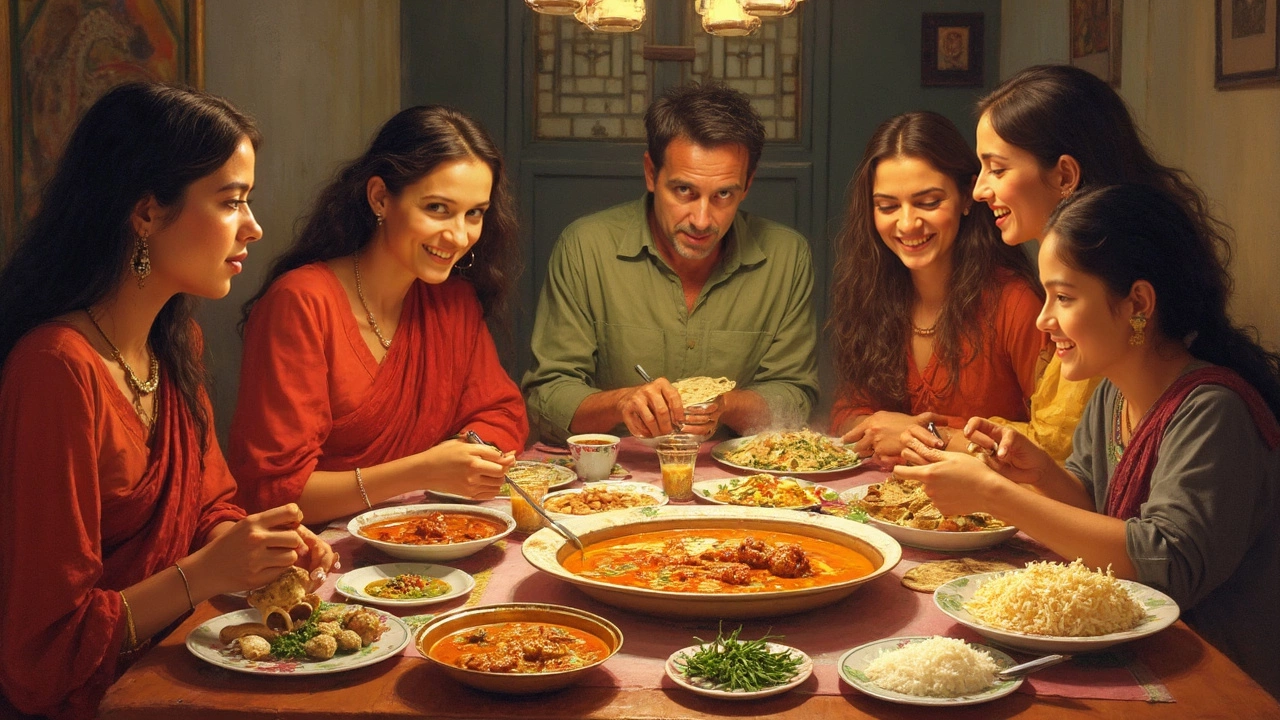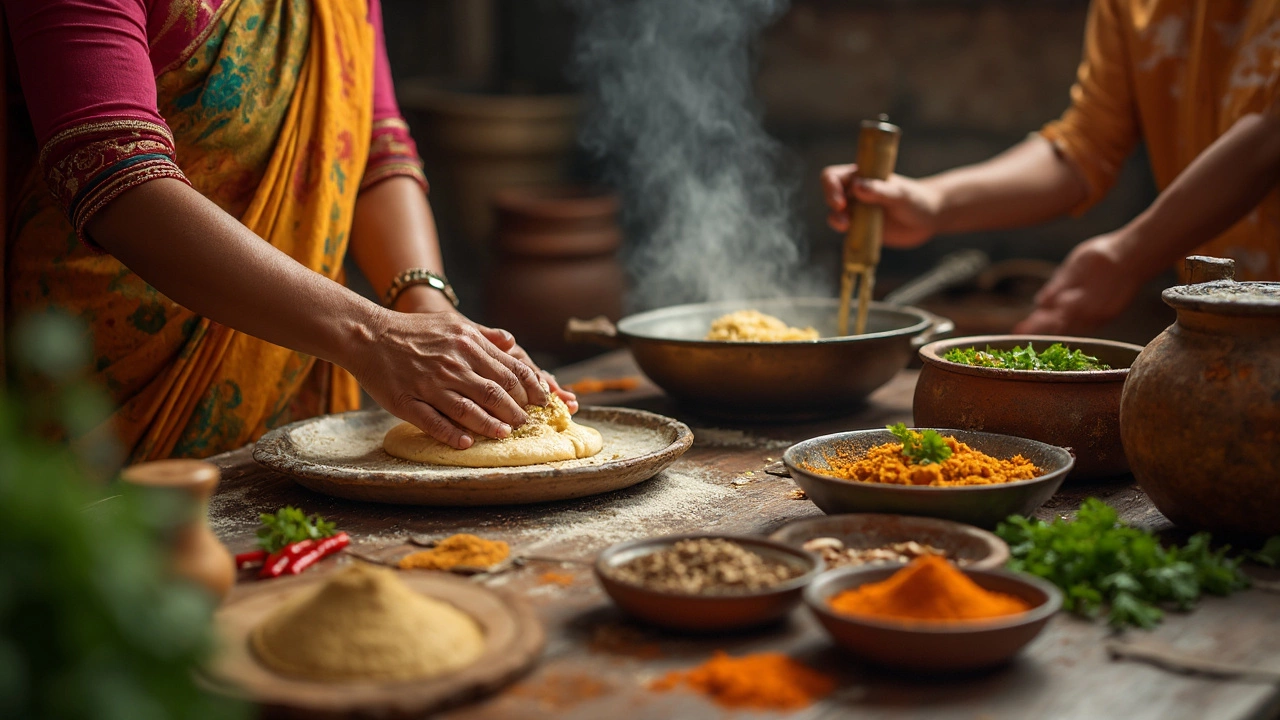You know those meals that just feel like a warm hug in food form? That's exactly what a traditional Indian lunch brings to the table. Think of it as a collection of comfort foods that are all about balancing flavors and tastes. Whether it’s the simplicity of rice or the warmth of freshly made rotis, there's something incredibly satisfying about this mid-day meal.
Now, if you're wondering what's usually on the menu, let's start with the basics: rice and roti. These are like the backbone of any Indian meal. Rice is often plain or spiced up a bit, while roti is our beloved flatbread, soft and fresh. Knowing how to make these can open up a world of recipes for you. And don't worry, they're easier than you think!
- The Staples: Rice and Roti
- Soulful Sides: Dal and Sabzi
- Spice It Up: Chutneys and Pickles
- Homey Comfort: Regional Variations
- Tips for a Perfect Indian Lunch
The Staples: Rice and Roti
In any traditional Indian lunch, rice and roti are the unsung heroes. These staple ingredients serve as the perfect partners to bold curries and comforting dals. Let’s get into what makes them so special.
First up, rice. While plain steamed rice is a go-to, there's also a variety like basmati renowned for its aroma and flavor. It's incredibly versatile and can be jazzed up into dishes like jeera rice, which includes cumin seeds for added taste. For the most part, white rice takes the crown, but brown rice is also gaining popularity among health-conscious folks for its added fiber.
Now, let's talk roti, the beloved Indian bread. Made from whole wheat flour, water, and a pinch of salt, it's all about technique. Knead the dough until smooth, let it rest, and then roll it into thin circles. Cook on a hot griddle and watch it puff up. Roti is super adaptable; you can spread some butter or dip it into curry.
Here’s a quick guide to making both staples:
- Rice: Rinse a cup of rice in water until the water runs clear. Bring two cups of water to a boil, add the rice, cover, and simmer on low until water is absorbed.
- Roti: Mix one cup of whole wheat flour with enough water to form a soft dough. Divide into small balls, roll out, and cook on a hot pan until spots appear on both sides.
Getting these basics right is key to making a meal that feels both satisfying and wholesome. Once you’ve mastered rice and roti, it’s like having a blank canvas ready for all the delicious flavors of Indian cuisine to come together in harmony.
Soulful Sides: Dal and Sabzi
When it comes to an Indian lunch, dal and sabzi are where the heart's at. They're the everyday heroes bringing warmth and flavor to your plate. Dal is like this comforting soupy dish made with lentils, and believe me, it's got more variations than you can imagine. Ever tried a simple Tadka Dal? It's just cooked lentils spiced up with tempering, like mustard seeds, cumin, and green chilies. Tasty and straightforward!
Sabzi, on the other hand, is all about the veggies. They come sautéed with spices, making them anything but ordinary. You get a mix of flavors from the earthy taste of potatoes to the slight bitterness of okra, all seasoned perfectly. Some timeless favorites are Aloo Gobi (potato and cauliflower) and Bhindi Masala (spicy okra).
Dals and sabzis not only taste great but are loaded with nutrients. Lentils in dal are packed with protein, while your mixed veggies boost vitamins and fiber. And the best part? You don't need to be a master chef to whip these up. Here’s a simple way to make a basic tadka for dal:
- Heat some oil in a pan.
- Add mustard seeds, cumin, and a pinch of asafoetida.
- Throw in some chopped onions and fry until golden.
- Add tomatoes, turmeric, and red chili powder.
- Pour this over your cooked dals and mix well.
And there you have it, dal and sabzi adding their magic to your traditional Indian lunch! These sides truly blend simplicity with flavor, making them a staple you won’t want to skip.

Spice It Up: Chutneys and Pickles
Alright, let's talk about the ultimate flavor enhancers in a traditional Indian lunch—chutneys and pickles. These bad boys might just seem like sidekicks, but they pack a punch that can make or break your meal. It's like the hot sauce on your burger or the gravy on your mashed potatoes; absolutely essential!
So, what exactly are they? Think of chutneys as thick, flavorful sauces, often crafted from fruits, vegetables, herbs, or spices. Each region in India has its twist on recipes, but common ones like mint chutney or tamarind chutney are universally adored. Mint chutney blends fresh mint, coriander, green chilies, and a squeeze of lemon to give any dish a refreshing zing.
Now, on to pickles. Not your average store-bought pickles, mind you. These are homemade delights, and each Indian household seems to have its secret recipe. They often feature raw mangoes, lemons, or gooseberries preserved in oil with an intense mix of spices. Imagine a spoonful of spicy mango pickle brightening up a simple plate of rice and dal, and you'll get why folks treasure them.
The beauty of chutneys and pickles is their versatility. You can whip up a basic mint chutney in about 5 minutes:
- Blend a handful of fresh mint and coriander leaves.
- Add a couple of green chilies, a clove of garlic, and a dash of salt.
- Squeeze in some lemon juice and mix until it's all smooth.
Enjoying Indian lunch isn't complete without these flavorsome sides. Whether you’re satisfying your daily tang craving or jazzing up an otherwise simple meal, these little extras make a big difference.
Homey Comfort: Regional Variations
India's rich diversity is mirrored perfectly in its cuisine. Each region boasts its own unique flavors, adding a personal touch to the traditional Indian lunch. Ever heard of the phrase "same-same but different"? That's exactly how you could describe Indian food across different states.
Starting in the north, Punjabi cuisine takes center stage with its robust flavors. Picture a chubby naan sitting next to a thick, creamy dal makhani. Then, there's sarson da saag with makki di roti, a winter favorite that warms the soul. These dishes don't just fill your belly; they're like a musical symphony of tastes.
Venture down south, and you'll find meals served on banana leaves, offering a true sensory experience. We're talking about a rice spread with sambar, rasam, and a variety of vegetable dishes known as sabzis. And don't forget curd rice; it's like a comforting end to a spicy meal, calming things down nicely.
Headed to the east? Look out for dishes like macher jhol in Bengal, which is a spicy fish curry served with steamed rice. Over in Odisha, the mati handi mutton is a delightful treat. The spices used here echo the cultural richness of the region.
In the west, cities like Mumbai bring together diverse flavors in dishes like poha and thalipeeth. Gujarati cuisine offers dhokla and the tech-savvy thepla—roll it, pack it, and take it to work.
What’s fascinating is how each region, despite using staples like rice and roti, crafts dishes that hold a unique story. Whether you’re trying your hand at Punjabi aloo paratha or a traditional South Indian dosa, these traditional recipes are steeped in culture, making each lunch an experience to remember.

Tips for a Perfect Indian Lunch
Nailing the perfect Indian lunch isn't hard when you know a few handy tricks. It's all about timing, balance, and flavor pairing. Here are some tips to make your midday meal an absolute delight.
First off, start with planning. Think about what dishes you'll prepare and how they complement each other. A common combo is a dal with a dry sabzi like aloo gobi. It keeps things interesting and provides a full experience.
Let's talk spices. They're the heart of Indian cuisine and can totally change the vibe of your meal. Have your basic spices like turmeric, cumin, and coriander on standby. Here's a quick tip: roast your spices before adding them to dishes to unlock their full potential.
Efficiency in the kitchen is a total game-changer. Use a pressure cooker for your dal to save time, and while it’s cooking, you can be making your roti dough or chopping veggies for the sabzi. It’s multitasking magic!
Consider preparing some fresh chutneys and pickles ahead of time. They stay good for a few days in the fridge and add a zesty punch to any meal. Trust me, a spoonful of mango pickle with rice and roti is literally a taste upgrade.
Finally, don't forget the presentation. Even a simple meal feels more special when it looks appealing on the plate. Arrange your rice in a neat mound, line up your roti, and place your curry or dal in a small bowl. These little touches do wonders.
Remember, it's not just about following recipes. Take the time to adjust the seasoning to your taste, explore regional variations, and savor each bite. With these tips, your traditional Indian lunch will be a hit every time!
